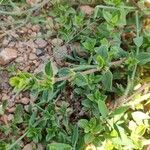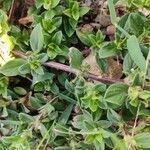Herbs, annual or perennial, or subshrubs, prostrate to perhaps weakly ascending, apparently often fleshy, to 50 cm tall; stems subterete to usually markedly quadrate, glabrous to puberulent or pilosulous on sides, angles cartilaginous to winged, wings to 0.1 mm wide, ciliolate, hispidulous, or ciliate. Leaves sessile to shortly petiolate; petiole to 4 mm, hirtellous throughout or ciliolate in lines; blade drying papery to leathery, oblong-elliptic, obovate, or spatulate, 10-30(-40) × 5-15(-18) mm, both surfaces hirtellous to scaberulous, hispidulous, and/or hirsute, base cuneate to obtuse and usually long decurrent, margin scaberulous or ciliolate and often revolute, apex acute, obtuse, or rounded; secondary veins 2 or 3(or 4) pairs or not visible; stipules moderately to densely puberulent, hirtellous, and/or pilosulous often in lines, sheath 1-3 mm, with 5-7 bristles 1-5 mm. Inflorescences axillary, 5-15 mm in diam., with 1-6 flowers per axil; bracts linear or infrequently stipuliform, 1-5 mm. Calyx puberulent to hirtellous or scaberulous; hypanthium portion ellipsoid, 0.8-1 mm; lobes 4, linear-lanceolate to narrowly triangular, 1-1.5 mm, ciliolate or ciliate. Corolla pink, purple, or white, funnelform, outside glabrous or hispidulous to pilosulous on upper part; tube 2.5-4.5 mm, glabrous in throat; lobes elliptic-oblong, lanceolate, or triangular, 1-1.8 mm. Capsules ellipsoid to subglobose, sometimes weakly flattened perpendicular to septum, 2.5-5 × 2.5-3.5 mm, puberulent, hirtellous, pilosulous, and/or hispidulous, papery to cartilaginous, septicidal from apex with valves usually remaining connected at base then both valves loculicidal through septum, with calyx lobes sometimes enlarging, up to 2.2 mm; seeds black, elliptic to elliptic-oblong in outline, 2.2-3 mm, obtuse at both ends, shiny to dull, surface minutely granular or dimpled. Fl. and fr. Mar-Dec.
More
Much-branched prostrate perennial herb forming mats up to 23–40 cm. wide; stems 10–20 cm. long, tinged reddish, covered with spreading white hairs, with short internodes and rather congested foliage.. Leaf-blades elliptic or oblong-elliptic, 0.6–1.5 cm. long, 1.5–6 mm. wide, ± acute at the apex, cuneate at the base, scabrid with white hairs on upper surface and particularly along the margins, also with hairs on midrib and nerves beneath; stipule-base hairy, ± 2 mm. long, with 3–6 fimbriae 3–6 mm. long; free petioles ± 1 mm. long or obsolete.. Flowers 1–several, sessile, in most leaf-axils.. Calyx-tube oblong-ovoid, 2 mm. long, densely hairy; lobes 4, lanceolate, 1.5–2 mm. long, hairy along the margins.. Corolla pale blue or lilac; tube narrowly cylindrical, 6 mm. long; lobes oblong, 2 mm. long, 1 mm. wide, hairy at the apex.. Filaments exserted 1 mm.. Style exserted 2.5–5 mm.; stigma shortly bifid, 0.8 mm. long.. Capsule obovoid, 3 mm. long, 2.7 mm. wide, with spreading white hairs.. Seeds chestnut-brown, oblong-ellipsoid, 2.5 mm. long, 1.2 mm. wide, 0.8 mm. thick, sometimes narrowed to one end, finely reticulate, ventrally grooved.. Fig. 50/20, p. 342.
A herb. The leaves are 1-2 cm long by 0.8-1.5 cm wide. They are narrowly oval. The flowers are in groups in the axils of leaves. They are pinkish-white. The fruit is a flattened capsule.
Open sandy lands at lower elevations in southern China. Behind beaches, in dry gardens, teak forests, along steep roadsides, on sandy soils, locally abundant, at elevations from sea-level up to 500 metres
More
It is a subtropical plant.



